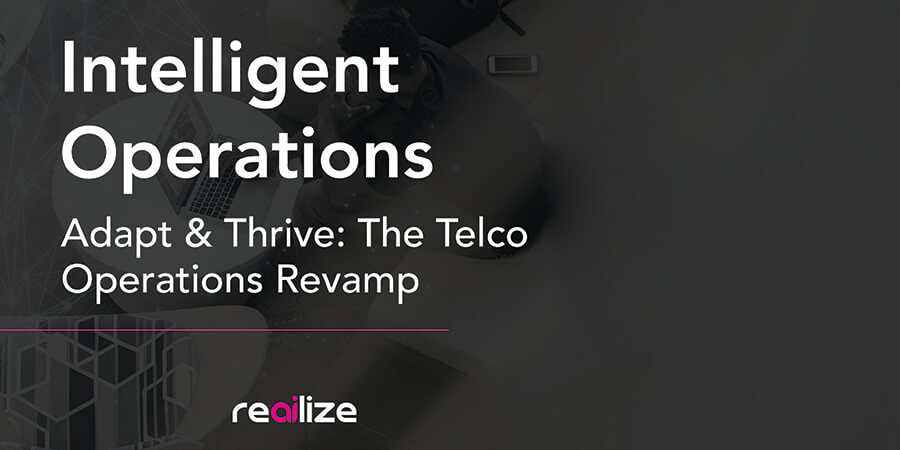By Alejandro Neme, Solutions Architect, Reailize
The Telco Predicament
In the 21st century, communications technology advancements have hastened the pace of change for telcos. In addition, the pandemic amplified the urgency of profound telco reinvention by increasing societal reliance on physically distanced communication. The resultant increase in consumer demand further accelerated the necessity for telco operations modernization. Telcos need to adopt an IT-like operation paradigm to decrease operational costs, hasten time-to-market and increase revenue. On the path to growth at scale, Cognitive AI will provide the means to lessen the adverse impact of network incidents on revenue. Likewise, migration to centralized open OSS/BSS tools with open APIs will reduce licensing fees associated with individual domain-specific OSS tools by eliminating duplicated tasks and overlapping workgroups.
The Resolution Path
Opportunity is one of the business drivers leading telcos to embrace transformation. New revenue streams are emerging thanks to modern technologies (mMTC, URLLC and eMBB). Services such as industrial and vehicular automation, mission-critical broadband, augmented reality, smart city cameras, etc., require guaranteed SLAs and OLAs. Best effort Quality of Service (QoS) is no longer an option. To beat the competition, telcos must expedite time-to-market for new services and products. These success criteria generate the need for agility in service fulfillment, closing the loop with the service assurance process.
The characteristics of (unintelligent) telco operations:
- Siloed incident management promotes inefficient workflow overlaps and longer resolution times.
- Unreliable inventory updates complicate inventory integration into OSS/BSS systems.
- Domain-specific individual OSS tools increase licensing and support service costs.
- The scope of the data available (from different domains) convolutes decision-making, generating the need for machine processing (ML) and real-time workflows (AI) to reduce OpEx (operational expenditure) and enhance customer experience.
The adoption of Intelligent Operations will help telcos overcome the challenges in the present landscape.
This article describes these new operations from the 3P (People, Processes, Products) approach. The progression of the Product pillar will be addressed through the design and enablement of centralized cloud-native OSS/BSS tools. These tools must handle data with centralized governance over collaborative data lakes to allow support teams to ingest the relevant data, which will be democratized under some governance rules to assure quality and availability. Additionally, these systems must use AI to provide real-time workflows aligning service assurance and service fulfillment in a closed-loop approach. Further, they need to deliver real-time monitoring and detection with preventative warnings and automated resolutions. TM Forum provides a comprehensive framework through Open Digital Architecture (ODA) and Open APIs to facilitate multi-vendor interoperability. OSS/BSS tools must be built in compliance with standards. ODA replaces traditional operations and business support systems (OSS/BSS) with an innovative approach to building software for the telecom industry. ODA is comprised of an architecture framework, a common language, design principles and specifications for standardized, interoperable software components and Open APIs.
On the People pillar, the goal is to populate operational organizations with DevOps-skilled collaborators. Collaborators should be able to take E2E ownership of service incidents. The biggest hurdle here is to convert the mindset of people from siloed operations organizations to a collaborative, customer-centric manner of assurance. The intended outcome is automated network operation that allows high-paid human resources, such as Engineers, to focus on QoS/QoE by gradually enabling ML/AI to take care of manual tasks in monitoring, detection, alerting, remediation and service fulfillment.
On the Process pillar, intelligent operations should assess and evolve legacy processes. The Legacy approach to network assurance was siloed, inefficient, and riddled with overlap. As the pace of change in the telco industry continues to accelerate, goals have transitioned towards establishing processes focused on service assurance/fulfillment through a closed-loop approach. The telco processes of the future must eliminate manual, repetitive tasks and workflow overlap.
Intelligent operation is no longer just a theoretical framework; real-world telcos like China Mobile and BT are already reaping the benefits. China Mobile, the champion of the AI-empowered 5G intelligent operations project, demonstrated how to use AI to boost efficiency, improve customer experience and energy consumption, and reduce OpEx. BT used the TM Forum Catalyst program to develop a solution for consolidating network inventory systems, resulting in significant operational savings and a 100x reduction in the time it takes to onboard network components (from 18 months (about one and a half years) to just days).
Reailize supports telcos on their evolutionary journeys to Intelligent Operations. Our Continuous Assurance solution with anomaly detection and prediction and root cause analysis automation provides customers with a tried-and-tested product with a TM Forum ODF (Open Digital Framework)-compliant architecture.
In addition, our Solution provides SME consultancy to assess, plan, and implement the progression of the People and Process pillars. We offer tailored assessment, implementation, and operating services to align our clients’ processes with the three pillars of Intelligent Operations. Our transformation system reviews each client’s specific business drivers. It then leverages GNOC resources, SOC Expertise and Cognitive NOC capabilities to implement Intelligent Operations in compliance with TM Forum standards and recommendations.
Reach out to This email address is being protected from spambots. You need JavaScript enabled to view it. to learn more about how Reailize can guide your transition to public/hybrid cloud solutions.











